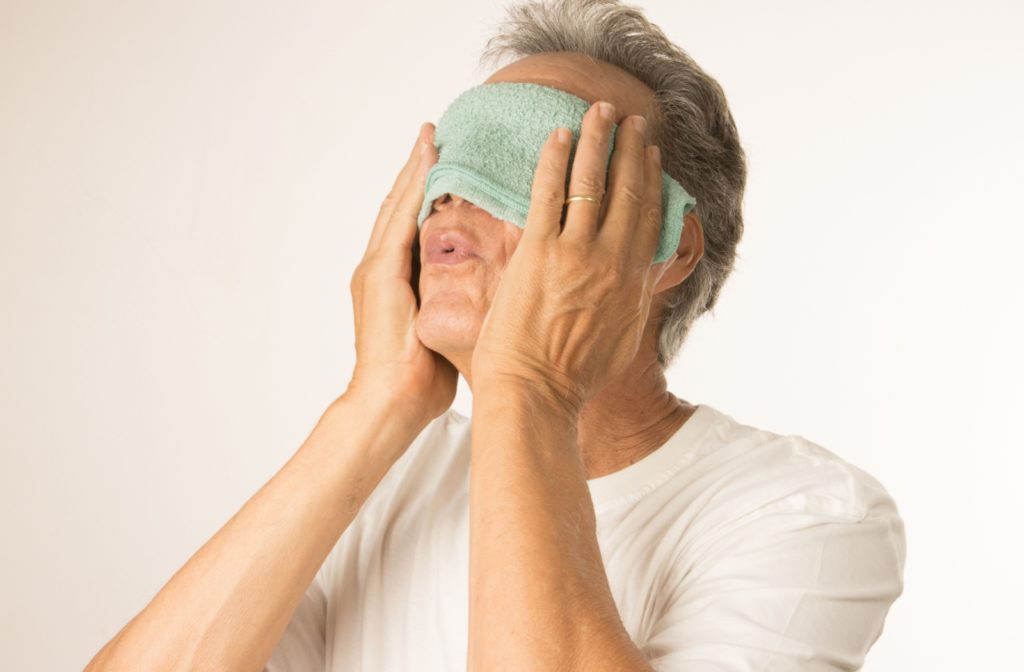Many people find eye swelling frustrating and uncomfortable. Finding the proper treatment is key to relieving discomfort caused by an injury, allergic reaction, or medical condition. Hot and cold compresses are two tried-and-true remedies that are accessible and effective.
However, the type of compress you will find more helpful depends entirely on the cause of your eye swelling: cold compresses better reduce swelling caused by infection or trauma, while warm compresses better relieve pain from swelling. If the swelling does not significantly reduce with at-home treatment, speak to your optometrist to see if your eyes are damaged.
Warm Compress vs. Cold Compress
Before deciding between a hot or cold compress, it’s helpful to understand how they differ and when each is appropriate.
A cold compress constricts blood vessels, reduces blood flow, and numbs the affected area. This makes it ideal for reducing inflammation and soothing irritation caused by swelling. On the other hand, a warm compress increases blood flow by dilating blood vessels and relaxing muscles. It is beneficial for improving circulation and alleviating eye discomfort caused by dryness or gland-related conditions.
Selecting the correct type of compress depends on the root cause and specific symptoms of your eye swelling. Using the wrong kind of compress may not provide relief and could even worsen your symptoms.
What to Know Before Using a Cold or Warm Compress
While hot and cold compresses are simple remedies, there are important considerations to keep in mind:
- Cleanliness is crucial: Always use a clean cloth or towel to avoid introducing bacteria to your eyes, which can worsen irritation or cause infection.
- Avoid excessive temperatures: Extremely hot or cold temperatures can damage sensitive eye tissues. Test the compress’s temperature on your wrist before applying it to your eyelid. It should feel comfortable, not extreme.
- Time matters: To avoid skin irritation or potential tissue damage, limit the time you apply a compress to about 10–15 minutes.
- Know the cause of swelling: If your eye swelling is accompanied by serious symptoms such as severe pain, changes in vision, or discharge, consult a healthcare provider immediately.
Now that you know the basics, let’s look at how cold and warm compresses can help with specific conditions.
Compresses for Eye Benefits
Conditions a Cold Compress Helps With
Cold compresses are most effective for treating swelling and inflammation caused by:
- Allergies: Seasonal allergies often cause puffy, itchy, or swollen eyes. A cold compress can calm the irritation and reduce puffiness.
- Eye injuries: The cold can reduce swelling caused by trauma, such as a bruise or bump, ease pain, and prevent further tissue damage.
- Pink eye or conjunctivitis (non-bacterial): Applying a cold compress can soothe the itching and irritation associated with conjunctivitis while reducing swelling from inflammation.
- Styes: Cold compresses can benefit styes in their early stages, particularly if they’re red and swollen, although warm compresses are often preferable as the stye progresses.
Conditions a Hot Compress Helps With
Warm compresses are better suited for conditions that require deeper relief and relaxation, including:
- Dry eye syndrome: Heat can stimulate oil production in meibomian glands, reducing dryness and discomfort.
- Blepharitis: This condition causes irritation and flakiness along the eyelid. A warm compress helps loosen debris and promotes gland function.
- Chalazion (Eyelid Cysts): Warm compresses can help reduce blockages in the oil glands, soften chalazions, and speed up healing.
- Eye fatigue: If your swelling is caused by strain (think of hours of screen time), a warm compress can relax tense muscles and alleviate discomfort.

How a Cold Compress Helps With Eye Swelling
A cold compress reduces swelling by constricting blood vessels and decreasing tissue fluid buildup. This process helps numb the area, easing pain while simultaneously calming inflammation.
How to Make a Cold Compress at Home
Creating a cold compress is simple and requires just a few household items:
- Wrap a few ice cubes or a bag of frozen vegetables in a clean washcloth.
- Alternatively, soak a clean cloth in cold water and wring it out.
- You can also use a gel pack designed for cold therapy, but make sure it’s wrapped in a thin cloth before applying it to your skin.
How to Use a Cold Compress
Follow these steps for effective application:
- Close your eyes and gently place the cold compress over your eyelid.
- Leave it on for 10–15 minutes, giving your skin breaks between sessions.
- Repeat this process 2–3 times daily or as necessary for relief.
When a Hot Compress Can Help With Eye Swelling
Hot compresses enhance blood flow and improve glandular function, beneficial for long-term eye health and conditions such as dryness or blepharitis.
How to Make a Hot Compress at Home
Here’s how you can create a soothing hot compress:
- Dip a clean washcloth into warm (not hot!) water.
- Wring out the excess water so the cloth is damp but not dripping.
- Warm compress masks explicitly designed for the eyes are another convenient and reusable option.
How to Use a Hot Compress
For best results:
- Close your eyes and gently position the warm cloth over your eyelids.
- Relax for 10–15 minutes, reheating the fabric as needed if it cools down.
- Perform this routine 2–3 times daily to support your recovery or ongoing eye care.
Which Compress Should You Use?
To decide whether to use a cold or hot compress, pinpoint the cause of your eye swelling. Cold compresses are ideal for reducing inflammation and soothing irritation, while warm compresses can relax and restore gland function. Both methods are invaluable tools in supporting overall eye health when used appropriately.
Total Vision Sports Area advocates for simplifying eye care. Whether you want to relieve swelling or manage a recurring eye condition, cold and warm compresses are simple, practical solutions that bring comfort and healing. Contact us today for help if your symptoms persist or worsen despite at-home care.



